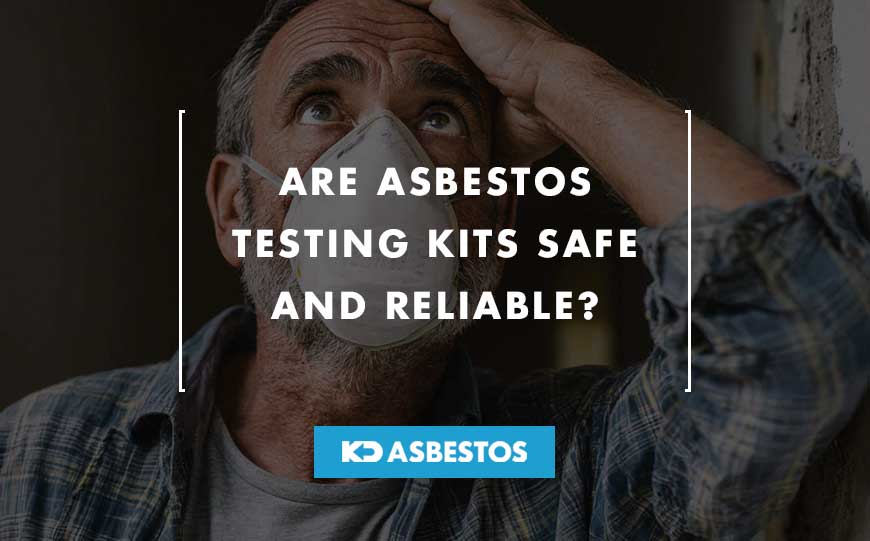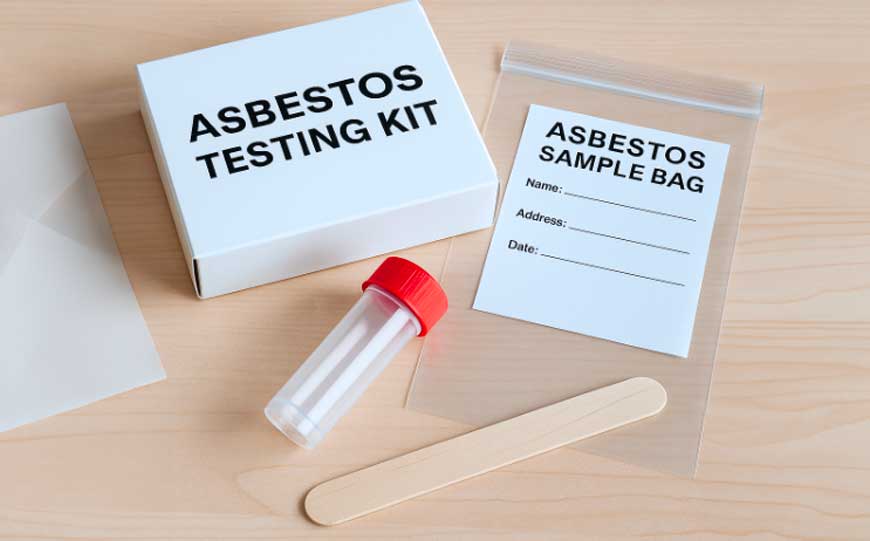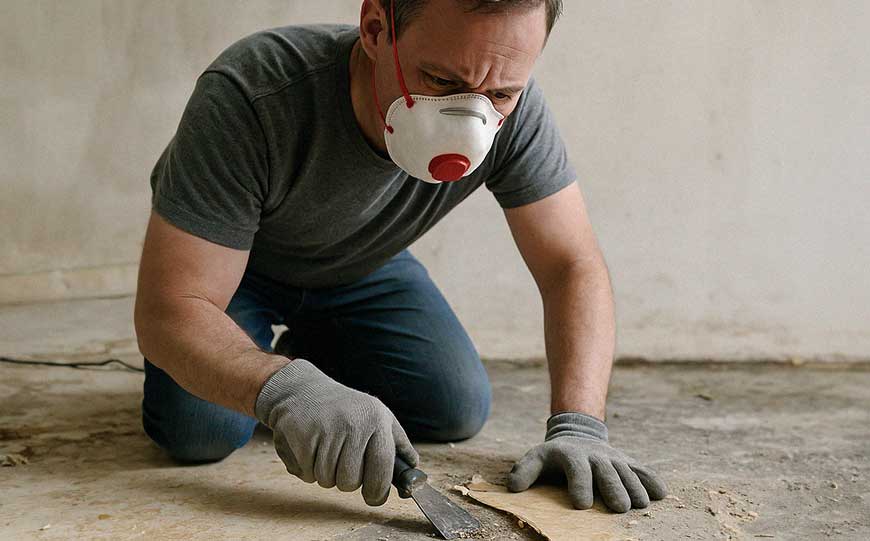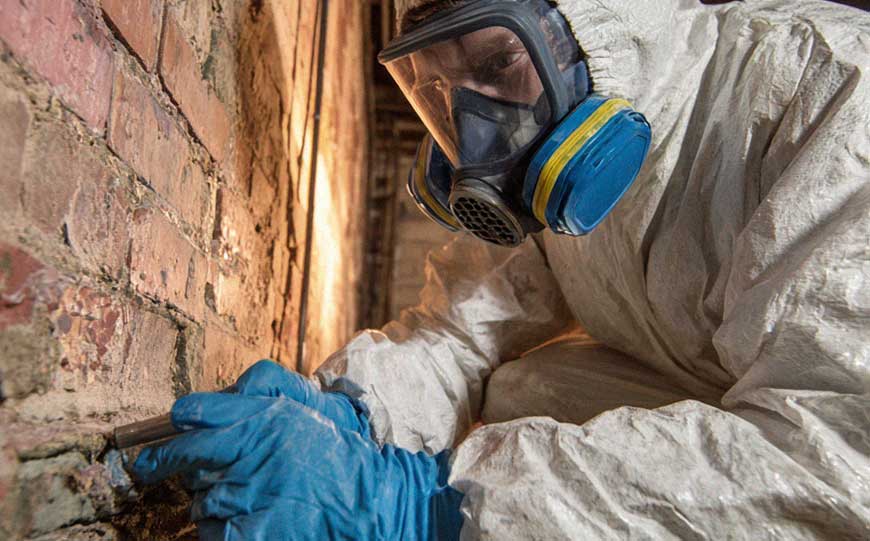
Asbestos was once a common building material, but it is now known to pose serious health risks when its fibres become airborne and inhaled.
Identifying asbestos in old insulation, tiles, cement, or other materials is crucial before any renovation or demolition work.
That usually means hiring licensed professionals to collect samples and analyse them in a lab.
In recent years, do-it-yourself asbestos testing kits have become available as a convenient alternative for homeowners.
These kits allow you to collect a sample of a suspected material and send it to a laboratory for analysis.
The big question is: are asbestos testing kits safe to use and can you trust the results?
Table of Contents
What are Asbestos Testing Kits?

Asbestos testing kits are DIY kits designed to help untrained individuals collect samples of materials for asbestos analysis.
They typically contain basic protective equipment and tools so that you can safely take a small piece of a suspected asbestos-containing material (often abbreviated as ACM) from your home.
It’s important to note that these kits do not actually test the material on the spot as you cannot determine by yourself if asbestos is present just by looking.
Instead, the kit provides the means to gather a sample, which must then be sent to a laboratory where professional analysts examine it under a microscope to check for asbestos fibres.
In other words, the ‘DIY’ part is only in the sampling, the actual testing is done by experts in a lab.
Typical asbestos testing kit packaging.
DIY kits provide the necessary tools (protective gear, sample bags, instructions) for safely collecting a small material sample to be analysed for asbestos.
Most asbestos home test kits include a set of personal protective equipment (asbestos mask and PPE) and sampling materials.
For example, a kit generally contains:
- Disposable coveralls
- Gloves
- Facemask (usually FFP3 grade for fine particles)
- Safety goggles
- Sealable sample bags
- Waste bags
- Cleaning wipes
- Instruction manual
Everything is packaged to help you take a sample as safely as possible and send it to the designated laboratory.
As long as you follow the instructions, using these kits is straightforward.
You suit up in the protective gear, take a small sample of the suspect material, seal it in the container provided, and mail it to an accredited lab for analysis.
The appeal of asbestos testing kits is that they are relatively inexpensive and convenient for checking a material in your home.
A basic kit in the UK might cost on the order of £35–£75 (depending on how many samples it covers and whether lab fees are included).
This is much cheaper than hiring a surveyor for a single sample.
They are sold by various suppliers and give homeowners an accessible option to address asbestos concerns without immediately calling in professionals.
How do Asbestos Testing Kits Work?

Using an asbestos testing kit typically involves several careful steps to ensure both safety and a good sample for the lab:
Preparation
Read the kit’s instructions thoroughly.
Put on all provided protective gear before you even approach the suspect material.
It’s wise to isolate the area by closing windows and doors and turning off any fans or HVAC systems.
Many guides recommend misting the material with water to dampen it and reduce dust or fibre release.
Lay down plastic sheets or paper to catch any debris.
Sampling
Carefully cut, scrape, or break off a small piece of the suspected material (typically coin-sized is enough) using a clean tool.
Aim to disturb the material as little as possible.
Just take the minimal sample needed.
If the material is layered (like some textured coatings or boards), try to include all layers in the sample.
Do not sand, saw, or create lots of dust.
Remember, asbestos fibres are microscopic.
You won’t see them, so assume they could be released if you’re not extremely gentle.
Bagging the Sample
Place the piece you collected into the provided sample bag.
The kits often instruct using a double-bag method to ensure containment.
Seal the bag tightly and wipe the outside with a damp wipe to remove any dust.
Label the sample bag as instructed.
Cleaning Up and Sealing
Use the cleaning wipes to wipe down any tools used and to clean the immediate area where the sample was taken.
Carefully place any debris, used wipes, and your disposable protective gear into the kit’s asbestos waste bag for disposal.
An important safety step is to seal the spot where the sample was taken.
This helps prevent any remaining asbestos fibres in that material from falling out later.
Double-check that no dust or fragments are left behind.
Dispose of all waste as instructed.
Sending to the Lab
Ensure the sample bag is sealed and any required paperwork is completed.
Most kits provide a pre-addressed envelope or container to send the sample to a specific laboratory.
Place the sample into the provided mailing container.
Send the package to the lab as soon as possible.
The laboratory analysis is typically done by specialists who will use microscopy techniques to determine if asbestos fibres are present in the material.
In the UK, labs conducting asbestos analysis should be accredited to ISO 17025 and employ trained analysts, which helps ensure a high standard of accuracy in results.
Awaiting Results
The time to get results can vary.
Many labs offer results within a few days to a week after receiving the sample.
Results are often sent by email or explained over the phone, and a written report may be provided.
The report will usually tell you whether asbestos was detected in the sample, and in some cases, it may specify the type of asbestos (such as chrysotile or amosite).
If your result is positive, you should then plan appropriate action, often by hiring a licensed asbestos removal or management professional to deal with the material.
If the result is negative, you’ll have peace of mind for that particular material.
However, be cautious as that result only covers the sample you took, and it is still possible that other areas could contain asbestos.
Are Asbestos Testing Kits Safe and Reliable?

While there is definitely an appeal of asbestos testing kits, the question is still ‘Are asbestos testing kits safe and reliable?’
For an answer to this, there are many different factors to take into account.
Safety Considerations
When it comes to safety, the primary concern with DIY asbestos testing kits is the risk of asbestos exposure.
Health Risks
All forms of asbestos are Class 1 carcinogens, meaning they can cause serious illnesses like mesothelioma, lung cancer, and asbestosis.
A properly designed kit provides protective gear to reduce this risk, but using it correctly is vital.
Even with an FFP3 mask and gloves on, an inexperienced person might accidentally disturb the material more than intended.
If done incorrectly, collecting a sample can be more hazardous than leaving the material alone.
Some asbestos-containing materials (for example, certain cement products or asbestos floor tiles) are not very dangerous when intact and untouched, and only become dangerous only when disturbed.
A novice trying to chip off a piece could inadvertently crumble the material, releasing microscopic fibres into the air.
Without professional containment measures, these fibres can linger and spread in the vicinity.
Quality of the Testing Kit
Kit quality and user handling also play a big role in safety.
The masks and equipment in some low-cost kits may not always be top-tier.
For instance, the disposable masks provided might not fit perfectly or filter every tiny fibre, especially if not worn properly.
Training
A homeowner might not be fully versed in safe asbestos handling.
Professionals undergo training to minimise fibre release.
An untrained person might make simple mistakes, such as breaking a sample too aggressively or not sealing off vents, which could spread contamination.
Waste
There’s also the matter of disposing of contaminated waste.
If you toss the used coveralls or the material debris in a regular bin, you could be creating a hazard.
Proper procedure is to double-bag and label asbestos waste and follow local regulations for hazardous waste disposal.
Reliability
Aside from safety, you might wonder if a DIY test kit will give you accurate and reliable results.
The reliability of asbestos test kits can be looked at in two parts – the laboratory analysis and the sampling quality.
The good news is that most kits on the market send your sample to certified labs that use proven methods to detect asbestos.
In fact, the only way to definitively identify asbestos is through lab analysis of a sample.
If your kit includes lab fees, it likely goes to a lab accredited for asbestos analysis.
So, the lab result for the sample you provided should be as reliable as any professional test.
The bigger reliability issue lies in the quality and representativeness of the sample you collect.
DIY testing kits are not normally as reliable nor as safe as hiring an asbestos consultant to take samples.
One reason is that a non-professional might not take the best sample.
Unless you have experience in asbestos surveying, it’s easy to make sampling errors.
For example, you might take too small a piece, or scrape only the surface of a material that has multiple layers.
If the sample isn’t representative of the whole material, the lab could give a ‘no asbestos’ result even though asbestos is present in parts you didn’t collect.
Without training, it is not always easy to take samples effectively, and the basic tools in a home kit might not guarantee that what you send truly represents the suspect material.
This false sense of security is dangerous because you might proceed to disturb asbestos unwittingly later.
Should I Use an Asbestos Testing Kit or Call a Professional?

Deciding between using a home asbestos testing kit versus hiring a professional comes down to weighing cost, convenience, and safety.
Both approaches have their pros and cons, and the right choice depends on your specific situation. To help you decide, consider the following guidelines:
A DIY asbestos kit might suffice if: you have a very limited area of concern and you feel capable of performing the sampling safely.
For example, perhaps you’re about to replace a single old linoleum kitchen floor, and you want to test one of the old floor tiles for asbestos before you proceed.
If time and money are factors, a kit provides a relatively quick and cheap solution.
Use a kit if you’re dealing with a small-scale test, are willing to follow all the safety steps scrupulously, and understand that the kit’s results apply only to the sampled material.
It can also be a useful first step.
If a kit confirms asbestos in the material, you will likely need professionals, such as us here at KD Asbestos, for removal.
If the kit result is negative, you might save yourself the expense of a contractor if that was your only area of concern.
Choose the DIY route in simple, low-risk scenarios where the suspected asbestos is contained and you just need a yes/no answer for that item.
Professional Testing
Professional testing is always recommended.
If your property is old and you’re planning major renovations or demolition, you should hire a professional to conduct a thorough asbestos survey rather than trying to sample here and there on your own.
A professional will inspect the entire area, identify all materials that might contain asbestos, and take appropriate samples.
Professionals have years of experience and training in what to look for and how to handle it.
They use specialised tools, and they know techniques to collect samples with minimal fibre release.
Furthermore, if you need official documentation, only a professional inspection will be recognised by authorities.
DIY vs Professional
In weighing the two options, ask yourself a few questions:
How large is the scope of the potential asbestos problem?
How confident am I in performing the safe sampling procedure?
What are the consequences if I get it wrong?
If it’s just a single material in question and you feel comfortable, a kit can answer that question.
But if the stakes are high (multiple materials, health risks, legal requirements, or simply uncertainty) it’s always better to call a qualified asbestos surveyor or consultant.
It’s not an all-or-nothing choice.
You might use a kit for an initial check and still involve professionals for removal or further inspection.
Your health and safety are paramount, so if there is any doubt, invest in a professional asbestos surveyor.
Key Takeaways
You should now have an understanding of asbestos testing kits and whether they are safe and reliable.
Asbestos testing kits can be safe and reasonably reliable when used correctly and in the right scenario.
They empower homeowners to take initial steps in asbestos identification.
But they are not a substitute for professional expertise in most cases.
Think of them as preliminary screening tools rather than comprehensive solutions.
If your situation is anything more than very straightforward, or if the asbestos in question is damaged or widespread, it’s time to call in licensed asbestos professionals.
Always prioritise health and safety: with a Class 1 carcinogen like asbestos, it is better to be overly cautious.
Ultimately, the goal is to manage asbestos risks effectively.
Stay informed, take all precautions, and don’t hesitate to seek expert help when needed, so you can protect yourself and others from the dangers of asbestos.
For more information on asbestos testing kits, or help with any of your asbestos needs, get in contact with us here at KD Asbestos today.